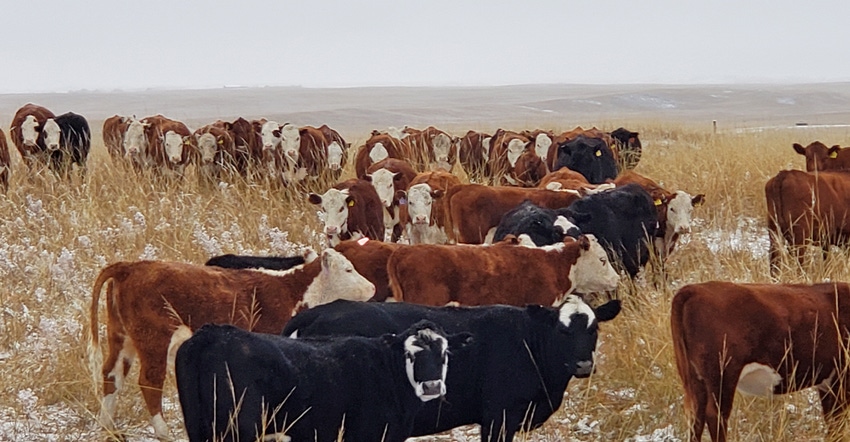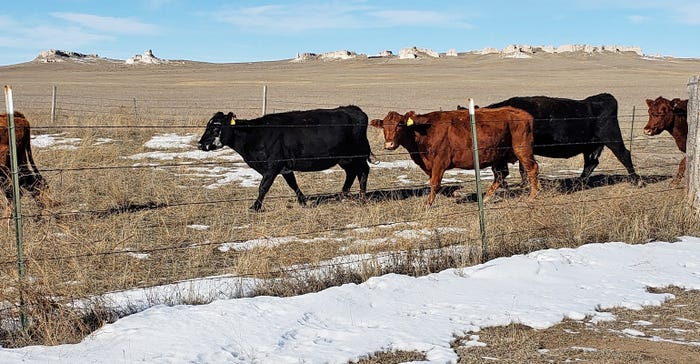October 25, 2019

“Is there anyone in the room who has year-round grazing without feeding hay?” asks Jim Gerrish during a four-day Management-intensive Grazing school held in Wyoming.
After a few hands go up, Gerrish adds, “I bet your neighbors are saying, ‘That can’t be done in this area. It just won’t work. If I’m feeding hay five months out of the year, there’s no way I can have 12 months of grazing.’”
When he hears things like that, Gerrish doesn’t hold back.
“I’ll respond, ‘Why are you in the cow business, because haying and feeding hay are the most expensive parts of being in the cow business? If you don’t think you have any alternatives, maybe you should think about being in a different business.”
Sage and Faith Askin, a young Wyoming ranch couple, have quickly learned that grazing irrigated pastures during both the growing season and winter pays bigger dividends than haying those pastures. This applies in all years except those when hay prices have gone through the ceiling.
They’ve adopted a practice that Gerrish preaches: grazing productive irrigated lands instead of strictly haying them. During the growing season, about 300 to 400 cow-calf pairs move through 1- to 10-acre paddocks every one to two days.
“We’ll achieve about 200 animal days per acre with grazing during the growing season, and we’ll swath-graze during winter, taking another 60 to 80 animal days per acre,” Sage says. The Askins rely on a combination of private, state and federal leases for cattle, sheep and goats.

SWATH GRAZING: In December 2018, old, short-term cows graze on dormant forage in a center-pivot-irrigated field leased by eastern Wyoming ranchers Sage and Faith Askin. “The alfalfa windrows really help the cattle to keep flesh in the often bitter-cold conditions in this area,” says Sage, who notes that the cattle spend about three days in each swath.

Taking a rest
Harold Stroh was among those cattle producers in Gerrish’s MiG class who is also changing the way he views grazing management.
“One sentence in Jim’s ‘Kick the Hay Habit’ book really struck me: That range scientists have come to believe that one of the best ways to invigorate native grasses in a semiarid environment is to give the pasture a full growing season of rest, and then graze it during winter.” says Stroh. (The full title of the book by Jim Gerrish is “Kick the Hay Habit: A Practical Guide to Year-Around Grazing.”)
In 2016, Stroh began resting a designated portion of his ranch near Lusk, Wyo., during the entire growing season. Only grazing that portion during winter allows a full season of growth, and he’s already seeing positive results.
“I can say with confidence that we are invigorating the native grasses,” Stroh says. “I’m really pleased that we’re seeing more warm-season grasses, because those were pretty much gone when we bought the ranch.”
Concerning the latter, he says, a more vibrant warm-season grass community is now providing actively growing forage during the heat of summer, when cool-season plants are dormant.
And this switch is having an added benefit when it comes to weed management. Cheatgrass, for example, is a major problem across Western rangelands — including the Lusk area and much of eastern Wyoming.
“I remain confident that by invigorating the native grasses, we will diminish the cheatgrass problem on our ranch and also reduce another undesirable plant, Japanese brome,” Stroh says. “But we know that this will take some time.”
Gerrish says winter grazing strategies like this typically take water developments and a combination of permanent and portable fencing, but this 180-degree change in management philosophy can dramatically cut down on costs associated with haying and winter feeding.
“I believe there is more money to be made in the cow-calf business by intensively managing cattle during winter, not only during the growing season,” Gerrish says.
Winter grazing and public lands
Because many ranchers in the West rely on a combination of private and public lands for grazing, a 180-degree change in grazing management becomes more difficult because the majority of public-land permits only allow grazing during late spring, summer and early fall, not winter.
“That’s why most of these ranches have gotten into the pattern of harvesting hay on all of their irrigated lands to feed that hay throughout late fall, winter and early spring,” Gerrish says. “By the time cows and their young calves are turned out onto rangelands, the forage is already losing its nutritional value; and then, during winter, we end up feeding very expensive hay to our cows. Basically, the current calving cycles and feed-quality cycles are out of whack.”
Gerrish encourages ranchers who hold permits to graze cattle on public lands conducive to winter grazing (notably, Bureau of Land Management rangelands) to visit with agency personnel about the merits of such grazing.
“You have to negotiate with the agency to get a permit change, and some district offices have been willing to make such changes. I have seen that happen at a number of different places,” he says.
For those who ranch in greater sage grouse country, there’s an added benefit.
“A change like this takes cattle off of sage grouse nesting and brood-rearing grounds,” Gerrish says. “Some of the ranches that have made such a switch on BLM rangelands have done it in conjunction with the Sage Grouse Initiative [of the USDA Natural Resources Conservation Service] .”
About the Author(s)
You May Also Like




